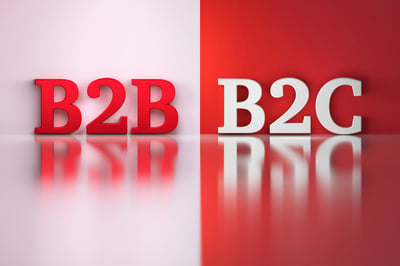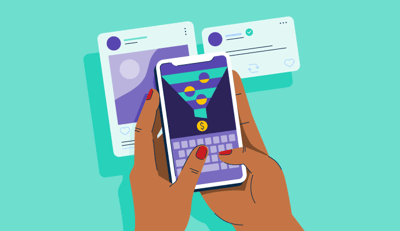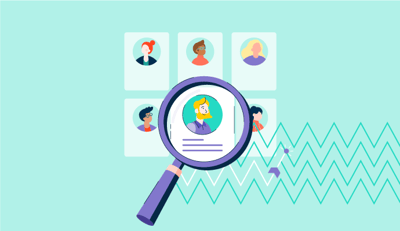May 21, 2020
 by Komal Helyer / May 21, 2020
by Komal Helyer / May 21, 2020

The need to stand out in a crowded marketplace is important across all industries.
If you want to increase your conversion rates and encourage customer loyalty, it is more important than ever to invest in the right strategies and technologies. To be able to do this, you need an understanding of the customer and where they are in their buying cycle. This is why customer lifecycle marketing is essential for the marketer to grasp.
The principles of customer lifecycle marketing remain the same across B2C and B2B, there also may be slight nuances depending on the individual business. We would recommend that you map out your own customer lifecycle stages after this crash course.
There are five main stages of the customer lifecycle:
The needs of your different customer personas will change depending on where they are in their journey with you, informing what content they require from you to help them move to the next stage.
To be able to deliver the best results at each stage, it is essential that you treat your customers and prospects differently based on their current needs. At each customer lifecycle stage, your prospects and customers will be trying to accomplish different tasks, asking different questions, feeling different emotions, and the marketing campaigns that you will send will need to address these differences along the way.
They are looking to find out more about why they should buy from you, your credibility, if they can trust in the service you provide, and if you have the kinds of products or services they may be looking for. They may not be specifically looking for anything yet or may not know exactly what they want, or they may have found you because they were searching for something specific and are moving toward the next stage, deciding whether or not to make a purchase.
In this stage when they are on your website, think about how to optimize your newsletter sign-up process to capture their attention and maximize conversions to opt in, as well as implementing a welcome and onboarding email program. Implement a targeted series of emails to introduce the new subscriber to your brand and offerings, and set expectations over the first 30 days of the relationship.
Consider the categories of products/services or the specific items they are browsing on your website, the blog posts they are viewing and the other pages they are navigating to. For example, if someone is viewing your FAQ page or delivery information, they are telling you they are looking for more information to help them make their decision, related to how your company operates.
Browsing multiple products in the same category (e.g. women’s skirts) tells you that’is the product type they’re looking for, but haven’t yet found the perfect one for them just yet. Browsing different types of blog posts tells you they are looking for inspiration, and looking at multiple posts in the same topic area also gives you more insight.
In this stage, you will also have more specific behavioral data such as searching for certain products, registering for back-in-stock notifications, or adding items to their basket and not going on to purchase them. Campaigns sent to prospects at this stage may include nurture communications to nudge them along. This will include using persuasive tactics such as social proof, case studies, or reviews.
You will also send regular promotional emails and newsletters to educate and inspire, following up on-site behavior such as browsing a specific product or category with a targeted series of emails to help them make the decision to purchase, or support an abandoned cart/form action with a reminder to purchase and other related product recommendations.
When their purchase arrives, how they feel about it, start to use it, and follow up with your company (reviews) are all part of this stage.
Campaigns during this stage will include, transactional emails (such as purchase and dispatch confirmation emails) and a post-purchase follow-up series (review requests) as well as helpful content to make the most of their purchase. This is a key step in building the relationship with the customer and ensuring an excellent experience that most companies neglect and instead only servicing the basic communications needed.
Offering up-sell and cross-sell items here can also be helpful to enhance the experience. These are some of the most important communications you will send again put the customer first – think about how you can go above and beyond to give them a fantastic customer experience.
Can you provide additional information following the purchase to help them make the most of their items? This could include showing them how to use the item properly (perhaps a short video or blog post), looking at the most common reasons customers return items and trying to combat these in your messaging and/or in your FAQs.
This stage is very similar to the research and consideration stage and many campaigns that you plan will be the same between the two; aiming to educate, excite and inspire them towards the next purchase (rather than the first purchase in the previous stage).
The thought process is the same for the customer before each purchase: what do I want to buy, and is this the right company to buy it from?
The difference from the initial purchase is that they now know they can trust you as a company as they have bought from you before. This is also why the previous stage (purchase and experience) is so important to get right and take beyond just the basic transactional communications that have to be sent in order to help bolster this
Focus on specific communications based on data you have about your subscriber including a birthday email or an anniversary of purchase email – campaigns that build loyalty and make the customer feel special.
You will also want to include campaigns that encourage a repeat purchase such as replenishment reminders for those products that run out (such as beauty products or razors) and further cross and upsell campaigns based on the last purchase.
Your standard promotional communications will also fall into this category in the cross over between this and the research and consideration stage, but think about how you can adjust these to make them more personal to the increased data you now have about these customers and their previous behavior. Use dynamic content to address them as previous customers or make product suggestions based on items they’ve already purchased for example.
Inactive subscribers are those who have become inactive with your email program and haven’t opened or clicked on your campaigns within a certain amount of time. Inactive customers are those who are no longer buying from you and who haven’t made another purchase within a specified amount of time. This will differ depending on your business and average purchase frequency that you would expect.
Implement an inactive subscriber reactivation series – a series of emails designed to re-engage a user who has not engaged with your email programme within a certain amount of time. You should also set up a series of emails to encourage inactive customers to come back and make another purchase.
There are many ways in which different messaging and tactics across the whole lifecycle can help reduce long term churn as well as the reactivation stage in the life cycle. Here are the things you can do.
It’s so important to remember we are selling and marketing to humans. It's human nature to care about purpose. We turn to science, philosophy, or religion to tell us why we are here. We seek career advice to help us find our calling and we start each New Year with a set of resolutions that give us focus.
After a customer has made a new purchase they may experience something called buyer’s remorse. This post investment anxiety can leave customers questioning if they spent their money well, whether they would get the experience they needed and whether it would deliver on their expectations.
A great way to combat this is to ensure there is a thorough onboarding process or post purchase nurture program that gives the customer information and help on the products or services they just purchased.
Finding ways to surprise and delight your customers helps your brand stand out from the competition. This can be achieved differently depending on your business. Examples could include:
Using various models including churn propensity/RFM/NPS it is essential to to identify unhappy customers as soon as possible. This allows you to turn things around quickly before they become totally disengaged.
Customer lifecycle marketing is the backbone of a successful marketing strategy. It ensures that you keep the customer at the heart of everything you do. However, to implement this strategy, you need marketing automation technology to help you deliver upon your communications; otherwise, it becomes a long and resource-heavy process.
The right technology will help you implement these programs and will trigger based on the customer's behavior. These automations will help you drive some of the best ROI across the whole marketing mix.
Komal leads the Pure360 marketing team, focusing on market positioning, market growth strategies, and customer lifecycle marketing. Komal has worked with some of the world's leading brands including HSBC, Carphone Warehouse, Black & Decker, and First Direct, helping them get the best results from their email and digital marketing. She sits on the DMA Email Council, the Chair of the Learning & Communications Hub and an awards judge including the DMA Awards & E-Commerce Awards.
You can distinguish between B2B vs. B2C marketing, but in the end, you must market for H2H:...
 by Axel Kuehnle
by Axel Kuehnle
Behind every great copy lie the three Cs of content: clear, concise, and compelling.
 by Brynne Ramella
by Brynne Ramella
Would you rather be addressed as “Hey there” or by your name?
 by Claire Brenner
by Claire Brenner
You can distinguish between B2B vs. B2C marketing, but in the end, you must market for H2H:...
 by Axel Kuehnle
by Axel Kuehnle
Behind every great copy lie the three Cs of content: clear, concise, and compelling.
 by Brynne Ramella
by Brynne Ramella


